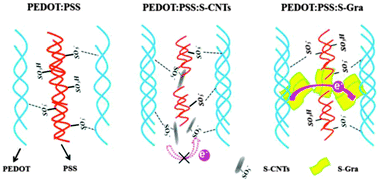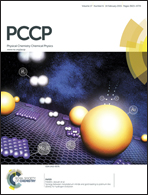A comprehensive study of sulfonated carbon materials as conductive composites for polymer solar cells†
Abstract
Sulfonated carbon nanotubes (S-CNTs) and sulfonated graphene (S-Gra) with superior dispersibility were successfully prepared to modify poly(3,4-ethylenedioxythiophene):poly(styrenesulfonate) (PEDOT:PSS) for applications in polymer solar cells (PSCs). The synergetic effect between S-CNTs/S-Gra and PEDOT:PSS could remove excess insulating PSS chains leading to an obvious phase separation between the PEDOT and PSS chains, which allows the formation of more conductive PEDOT channels. The PEDOT:PSS (Clevios PH 4083):S-CNTs with well-matched work function, favorable morphology, optimized hydrophobicity and superior hole mobility is demonstrated to be an excellent hole transport layer (HTL) for PSCs. However, the PEDOT:PSS (Clevios PH 4083) modified by sulfonated graphene with stacked and wrinkled lamellae as an HTL renders a rough morphology and has a negative impact on the morphology of the active layer, consequently resulting in a poor device performance. Excitingly, PEDOT:PSS (Clevios PH 1000) modified with S-Gra shows high conductivity, because the sulfonated graphene lamellae contribute to the connection between the insulator and conductive PEDOT islands and improves the charge conduction. The PH1000:S-Gra with multiple layers presents excellent electrical conductive properties and a high transmittance (sheet resistance of ∼45 Ω sq−1 and transmittance of ∼85.5% at 550 nm), which possess great potential for its application as a transparent conductive and flexible electrode in organic electronics.


 Please wait while we load your content...
Please wait while we load your content...